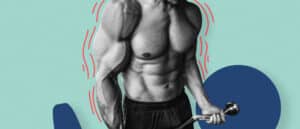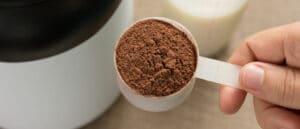What the Heck Is a Bro Split?
Fast Facts
- A bro split is a simple training schedule that trains each major muscle group once per week on different days of the week.
- Bro splits prioritize working at a high volume to increase hypertrophy (or muscle growth) and achieve a pump.
- Bodybuilders and recreational lifters praise bro splits for their simple approach to progressive overload while ensuring ample rest and recovery.
Attach the word bro to almost anything, and it’s enough to send the best of us packing. Although, not all things that fall under the ‘bro’ umbrella are bad.
Example A: the bro split.
A bro split routine is an approach to workout programming that is highly popular among bodybuilders and recreational lifters who praise it as a simple approach to building muscle size and strength.
Thanks to its name, the bro split has attracted plenty of haters—but is it deserved?
Just like every training split, the success of a bro split really comes down to how it’s programmed. Plan your exercises, sets, and reps wisely and you can make gains using a bro split. Find out how below.
What Is a Bro Split?
A bro split is a workout program scheduled to train each major muscle group once per week on different days of the week.
A 5-day bro split usually looks something like this:
- Monday: Chest
- Tuesday: Back
- Wednesday: Shoulders
- Thursday: Legs
- Friday: Arms
- Saturday and Sunday: Rest
Because muscle groups only get hit once, bro splits typically involve a generous amount of sets and reps per workout—leaving the target muscle group taxed and pumped. Then you get a full week to recover before hitting it again.
Do Bro Splits Work?
Bro split routines can be effective for certain people in certain circumstances, but it largely comes down to how it’s programmed. Assuming you’re progressively overloading the body—increasing total volume and weight over time—bro splits can promote muscle growth.
This split is great for recreational lifters who want to gain strength but don’t need to lift for maximum strength (unlike elite athletes who may benefit from training muscle groups at a higher frequency). It’s also great for bodybuilders who care more about hypertrophy (muscle size) than overall strength.
Bro Split Workout Routine
There are a ton of different ways to program bro split workouts. The exact exercises, sets, reps, and load will vary dramatically from person to person depending on their goals. As long as you prioritize progressive overload (lifting heavier over time) you will see progress.
“Pick a primary exercise for each training day to lift heavy,” says Davidson, “this will help keep your strength in check.” He also points out that since your training volume per session will be higher than normal, you may not be able to go heavy on every exercise. Instead, he recommends lifting heavy on the first few exercises and focusing more on volume for the remainder of the workout.
Below, is an example of how to break down a bro split just like Davidson recommends. Feel free to plug and play your own exercises to mix up your routine, but we’d recommend keeping the order of workouts the same.
You’ll work similar muscle groups on chest and shoulder days, which is why we’ve sandwiched them around a back day to give them rest while you continue working on other muscles. Similarly, back and leg days share muscle groups, so the shoulder day in between provides needed recovery.
|
Day 1: Chest |
||
|
Exercise |
Sets |
Reps |
|
Barbell Bench Press |
4 |
5-8 |
|
DB Incline Bench Press |
3 |
8-10 |
|
Lean Away DB Lateral Raises |
3 |
8-10 |
|
3 |
10-12 |
|
|
Dips |
3 |
10-12 |
|
Pushups |
3 |
10-12 |
|
Day 2: Back |
||
|
Exercise |
Sets |
Reps |
|
Deadlift |
4 |
5-8 |
|
Lat Pulldown |
3 |
8-10 |
|
Bent Over Row |
3 |
8-10 |
|
Single Leg Deadlift |
3 |
10-12 |
|
Inverted Row/Pull Ups |
3 |
10-12 |
|
Farmer’s Carry |
3 |
45 seconds |
|
Day 3: Shoulders |
||
|
Exercise |
Sets |
Reps |
|
Standing Overhead Press |
4 |
5-8 |
|
Incline DB Bench Press |
3 |
8-10 |
|
Upright Row |
3 |
8-10 |
|
Reverse Fly |
3 |
10-12 |
|
Shoulder Shrugs |
3 |
10-12 |
|
Single Arm Kneeling Kettlebell Press |
3 |
10-12 |
|
Day 4: Legs |
||
|
Exercise |
Sets |
Reps |
|
Back Squat |
4 |
5-8 |
|
3 |
8-10 |
|
|
3 |
8-10 |
|
|
Bulgarian Split Squat |
3 |
10-12 |
|
Lateral Lunge |
3 |
10-12 |
|
Calf Raises |
3 |
10-12 |
|
Day 5: Arms |
||
|
Exercise |
Sets |
Reps |
|
Close Grip Bench Press |
4 |
5-8 |
|
3 |
8-10 |
|
|
Cable Tricep Pushdowns |
3 |
8-10 |
|
Zottman Curl |
3 |
10-12 |
|
Overhead Tricep Extensions |
3 |
10-12 |
|
Hanging Leg Raises |
3 |
10-12 |
Bro Split Pros
It’s simple
If you want to gain muscle but struggle with what to do when you step foot in the gym, bro splits offer a simple solution. Each workout has a specific goal so you know exactly what you’re training for.
It gets you on a regular program
Following a program is almost always more effective than not—even if the program isn’t perfect. Why? “Having a plan helps to keep you accountable towards your goals,” says certified personal trainer Matt Davidson, CSCS.
Davidson also points out that bro splits make it easy to achieve progressive overload since they typically involve more training volume than other programs.
It results in a pump, every time
Dedicating an entire session to one muscle group means you can hit it with enough volume to achieve a pump. Vanity benefits—ranging from looking good for date night to personal hype—abound, but one study suggests the process of getting pumped can also hit the accelerator on muscle growth (1).
It hammers upper body
Dudes love to hit upper body. If you’re one of them, you’re in luck. Following a traditional bro split, you’ll be hammering your upper body four out of five days of the week.
That isn’t the only way to break it down, though. “If you’re not seeing growth with a single leg day each week, add in a second lower body day,” says Davidson. “If you’re on a time crunch, you may need to sacrifice some training volume in a different area, but this is a small price to pay for big lower body gains.”
He notes his favorite way to pack in lower body work is by hitting back and legs on the same day. Rest for a few days, then hit lower body again.
Bro Split Cons
Not the best for beginners
Bro split workouts are hard. It’s essentially packing all the work for one muscle group—typically completed in several sessions throughout the week—into one day. Newer lifters may find this training load is simply too much in a single session.
The solution: simply plan shorter sessions with less total workload and progressively increase your volume over time. Or, pick a different split that spreads the work into two to three days a week with adequate rest between sessions so your muscles feel fresh and primed to give their best.
Not great for max strength
When training for strength, lifting heavy loads is key. The heavier the load, the more taxing the lift—which is why most strength training programs cut back on reps, and increase rest to maximize the weight lifted.
You could argue as long as you’re hitting the same volume (sets, reps, and load) there should be no difference in gains (2). This might ring true for hypertrophy training where volume is king, weight is lower, and work sets are easier than a strength-focused routine.
Try packing all the work for one muscle group into a single strength session though, and you’ll likely find you have to cut back on weight just to get through the workout. Once you drop weight, you’re not really training for strength anymore—you’re likely hitting hypertrophy or endurance training which can still help you build muscle strength, size, and tone; but, not as much strength as a true strength regimen.
To prioritize strength, one study found training two to three times a week, with volume spread out over the course of the week, is ideal for improving strength while minimizing fatigue (3).
Too much isolation, too little compound
The basis of bro splits is muscle group isolation, which is why they often prioritize machines over free weights. Our muscles don’t work on their own IRL—we push, pull, hinge, squat, carry, and rotate.
The good news: you can program your bro split to include more compound exercises using free weights to train functionally. If you do, just be careful about how it’s programmed to give those muscle groups adequate rest over the next few days.
For example, bench press works your chest, shoulders, and triceps so you might want to plan a back or leg day after chest day rather than a shoulder or arm day. This will give your shoulders and triceps adequate recovery before hitting them again.
Bro Split Versus Other Routines
Here’s how the bro split compares to other training routines.
Bro Split Versus PPL (Push Pull Legs)
The bro split is the exact opposite of a PPL split—which focuses on the movement rather than specific muscles. A PPL split breaks up workouts into push, pull, and legs to maximize work and rest.
Both are good workout programs and your choice should depend on your fitness goals. If you’re interested in focusing on specific muscle groups, the bro split is a better choice. If you want to gain muscle with a more flexible schedule, the PPL split might be a better option.
Bro Split Versus Full Body
A full-body split trains all of the major muscle groups in your body in each workout. Your schedule may involve two or three full-body workouts a week.
Both splits are great options for building muscle, the choice comes down to your schedule. With a full-body split, you’ll spend fewer days at the gym, but each workout will need to be longer to hit all body groups in one go. With a bro split, you’ll spend at least five days a week at the gym but your workouts will be a bit quicker since you’re only focused on one major muscle group at a time.
Bro Split Versus Upper Lower
An upper-lower split involves training each muscle group twice, four days a week—with two upper body days and two lower body days. The advantage: you train each muscle group at the right frequency in fewer training days.
But there are trade-offs. Namely, because you have to hit both push and pull muscles in a single upper-body session you’ll have to work through exhausted muscles to get the right training volume on each. A bro split is better for upper body because you get one day to focus on each muscle group when they’re fresh.
The Bottom Line
A bro split is a simple and effective workout programming method that can help you build muscle strength and mass. Plan adequate rest and progressive overload for best results.















